
The Rijksmuseum is the national museum of the Netherlands dedicated to Dutch arts and history and is located in Amsterdam. The museum is located at the Museum Square in the borough of Amsterdam South, close to the Van Gogh Museum, the Stedelijk Museum Amsterdam, and the Concertgebouw.

Maarten van Heemskerck or Marten Jacobsz Heemskerk van Veen was a Dutch portrait and religious painter, who spent most of his career in Haarlem. He was a pupil of Jan van Scorel, and adopted his teacher's Italian-influenced style. He spent the years 1532–6 in Italy. He produced many designs for engravers, and is especially known for his depictions of the Wonders of the World.

Workum is a city located in the municipality of Súdwest-Fryslân in Friesland, Netherlands. It received city rights in 1399 and is one of the eleven cities of Friesland. It had a population of 4,435 in January 2017.

The Frans Hals Museum is a museum located in Haarlem, the Netherlands.

Teylers Museum is an art, natural history, and science museum in Haarlem, Netherlands. Established in 1778, Teylers Museum was founded as a centre for contemporary art and science. The historic centre of the museum is the neoclassical Oval Room (1784), which was built behind the house of Pieter Teyler van der Hulst (1702–1778), the so-called Fundatiehuis. Pieter Teyler was a wealthy cloth merchant and banker of Scottish descent, who bequeathed his fortune for the advancement of religion, art, and science. He was a Mennonite and follower of the Scottish Enlightenment.
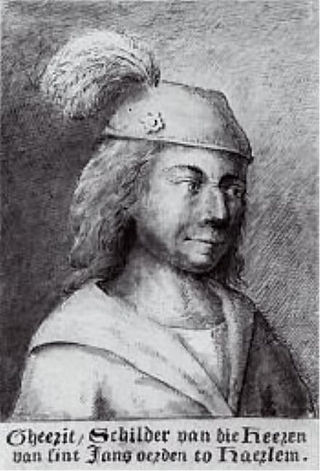
Geertgen tot Sint Jans, also known as Geertgen van Haarlem, Gerrit van Haarlem, Gerrit Gerritsz, Gheertgen, Geerrit, Gheerrit, or any other diminutive form of Gerald, was an Early Netherlandish painter from the northern Low Countries in the Holy Roman Empire. No contemporary documentation of his life has been traced, and the earliest published account of his life and work is from 1604, in Karel van Mander's Schilder-boeck.
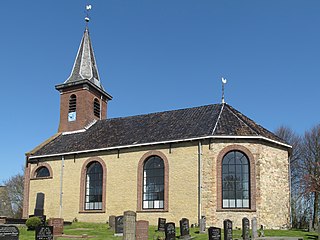
Herbaijum is a village in Waadhoeke municipality in the province Friesland of the Netherlands and had around 253 citizens in January 2014. Until 2018, the village was part of the Franekeradeel municipality.

Marsum or Marssum is a village in Waadhoeke in the province of Friesland, the Netherlands. It had a population of around 1,052 in January 2017. Before 2018, the village was part of the Menameradiel municipality.

Malle Babbe is a painting by the Dutch Golden Age painter Frans Hals, painted c. 1633-1635, and now in the Gemäldegalerie, in Berlin. The painting has also been titled as Hille Bobbe or the Witch of Haarlem. It was traditionally interpreted as a tronie, or genre painting in a portrait format, depicting a mythic witch-figure. The painting is now often identified as a genre-style portrait of a specific individual from Haarlem, known as Malle Babbe, who may have been an alcoholic or suffered from a mental illness.
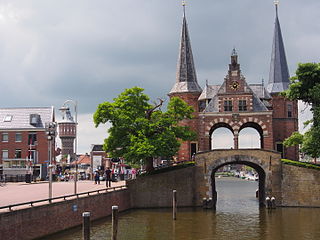
Southwest Friesland is a municipality in the Northern Netherlands, located in the province of Friesland. It had a population of 84,092 in August 2017. Sneek is the municipal seat. With a total area of 841.56 km2, Súdwest-Fryslân is the largest municipality by area in the Netherlands.

Pieter Biesboer, is a Dutch art historian and prolific writer on 17th-century Dutch art. His specialty is art from Haarlem.
Pieter Haaxman, was a Dutch painter whose work is held in museum collections in the Netherlands.
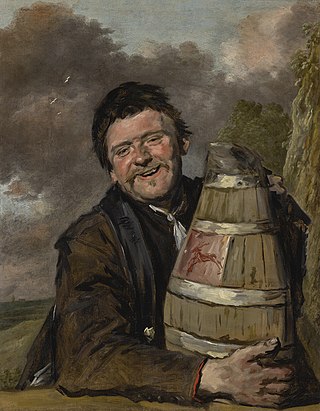
Man with a Beer Jug is an oil-on-canvas painting by the Dutch Golden Age painter Frans Hals, painted in the early 1630s, now in a private collection.
Sanneke de Neeling is a Dutch speed skater who is specialized in the sprint and middle distances.
Bernhardus "Bernhard" van Haersma Buma was a Dutch politician and writer. As politician he was part of Christelijk-Historische Unie (CHU) and later CDA. He was mayor of Workum and Sneek.

Portrait of Stephan Geraedts, Husband of Isabella Coymans is an oil on canvas painting by Dutch Golden Age painter Frans Hals. The painting was originally part of a couple of pendant wedding portraits. Hals probably painted the present portrait, Stephanus Geraerdts', alderman in Haarlem, and the accompanying portrait of the latter's wife Isabella Coymans around 1650–1652, six or seven years after their marriage in 1644. Isabella's portrait is now in a private collection in Paris.

Habtamu Emke de Hoop is an Ethiopian-born Dutch television presenter and politician. He served as a member of the municipal council of Súdwest-Fryslân between 2018 and 2021, and he hosted the educational children's show Het Klokhuis. De Hoop was elected to the House of Representatives in March 2021 as a member of the Labour Party (PvdA).
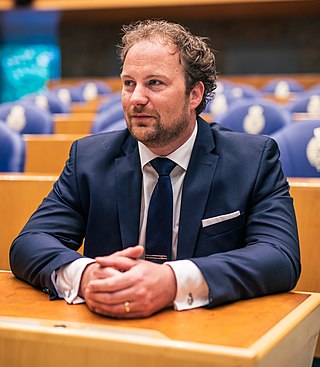
Romke Harke de Jong is a Dutch entrepreneur and politician of the social liberal party Democrats 66 (D66). He took over and expanded his father's ice cream catering company and served on the municipal council of Opsterland in Friesland between 2010 and 2018. De Jong became a member of the States of Friesland the following year, and he was elected to the House of Representatives in the 2021 general election.
Tiny Hoekstra is a Dutch women's footballer, who plays for Ajax. She previously played for Heerenveen between 2012 and 2021, and was the top scorer in the 2018–19 Eredivisie. Hoekstra has played for the Netherlands under-17, under-19 and under-21 teams.
















